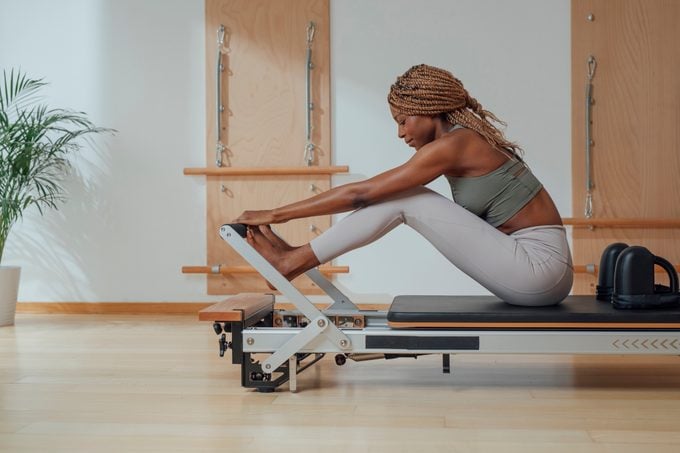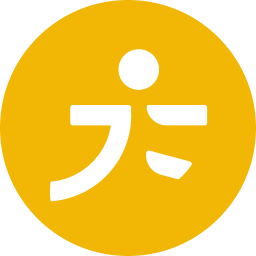Pilates includes low-impact exercises and small movements that focus on the core. Here’s how the practice can help you slim down.
What is Pilates?
No matter how zealously practitioners praise Pilates, casual exercisers approach it with a certain degree of skepticism. Isn’t it a lot of core work, they think. All that mind-body stuff sounds complicated. And what on earth is that machine?!
If that sounds like you, you may be missing out on one heck of a workout.
The practice, which was founded by Joseph Pilates and brought to the United States in the 1920s, does indeed focus on the core as your center of movement.
But it’s also all about small movements and low-impact exercises that test your flexibility and range of motion.
Pilates moves build and rely on strength, endurance, stability, and a mind-body connection, says Enja Schenck, a New York City-based Pilates teacher and exercise science lecturer at Lehman College.
Pilates takes a mindful approach to exercising the entire body, and it helps you to get to know where your body is in space.
The moves are typically done on a mat or a machine called a reformer. These days, you’ll find Pilates incorporated into physical therapy practices as well as in boutique studio classes.
“It’s really everywhere now,” Schenck says. “It spans the gap between fitness and yoga.”
Considering the many movements a Pilates workout entails, many people wonder whether the practice can help with weight loss. The answer is complicated.
Will Pilates help me lose weight?
Weight loss comes down to calories in versus calories out. So exercise isn’t the only component of a weight-loss program. “If you want to lose weight, the most important thing is to be in a caloric deficit,” Schenck says.
If weight loss is your ultimate goal (as opposed to, say, getting some exercise), you’ll need to pay attention to diet. That means focusing on the number of calories you take in to make sure you’re not getting more than you expend during physical activity.
The amount of calories you’ll lose with Pilates depends on several variables, including your weight, how difficult your Pilates class is, and whether you’re using a mat or reformer.
According to a study of 15 healthy women, sponsored by the American Council on Exercise, a 150-pound person can burn 175 calories at a beginner 50-minute Pilates mat class, compared with 254 calories at an advanced 50-minute mat class.
On a whole, the research on Pilates for weight loss is somewhat inconclusive.
On the one hand, a recent meta-analysis published in Frontiers in Physiology found that people who were overweight or obese reduced their body weight, body mass index, and body fat percentage via Pilates.
On the other hand, the researchers noted that more randomized controlled studies are needed to firmly back this up.
Meanwhile, a meta-analysis published in 2020 in the Journal of Physical Activity and Health found Pilates didn’t reduce body composition any more than other forms of training or control groups.
The good news is there aren’t any downsides to trying Pilates for weight loss, as long as your doctor says it’s OK. Even if it’s not a massive calorie-burning activity, it may aid your weight-loss goals in less-direct ways. Read on to find out how.
Pilates may help you keep a consistent routine
The reason you want to find a workout you love? The more you move, the more calories you burn. So you want to do an exercise that’ll keep you coming back for more. Pilates is one of the best workouts for people who hate exercise.
The American College of Sports Medicine recommends 30 minutes of moderate-intensity aerobic activity five days a week and muscle-strengthening activities at least two times per week. “If you have to move that much, you want to do something that you like, especially if it helps you reach your goals,” Schenck says.
When you’re first kicking off a workout routine, figure out what you like (that’ll help you stick to it) and consider what is doable, says Nandini Collins, a certified personal trainer and senior health coach manager with the weight loss app Noom.
“In terms of doable, ask yourself what can be done within your financial, space, and physical limitations,” she says.
If Pilates comes up winning in all three areas, make it a regular practice.
You can opt for fast-paced classes
While Schenck suggests other, more-intense forms of movement for those looking to lose weight, she also says that if you love Pilates, stick with it.
After all, a less-intense workout that you actually do will have better health benefits than a more-intense workout you skip 99 percent of the time.
If you can, she says, opt for more-rigorous Pilates classes, which will up the caloric burn and help with that calorie deficit.
Collins agrees, suggesting that people looking to lose weight search for Pilates classes that also bring in elements of high-intensity interval training (HIIT).
“This combination maximizes caloric burn via cardio as well as the fat-burning efficiency achieved through strengthening muscles through Pilates,” she says.

Pilates is a good option for those who need low-impact exercise
Pilates can be particularly beneficial for anyone with injuries, Collins says.
The low-impact approach makes it less jarring on the muscles and joints than other cardio exercises. The practice may be an especially good choice for people with back pain.
If certain health conditions or injuries have made it hard for you to find a workout routine that works, talk to your doctor about Pilates.
It may be a good way to get active again. And that can help you burn more calories.
It can help you build lean muscle mass
Like weight training, Pilates will help you build muscle. And get this: building more muscle will help you burn more calories at rest.
At least one small study, published in the West Indian Medical Journal, supports the idea that Pilates helps build muscle. Researchers assigned a group of sedentary women ages 60 and older to either an eight-week Pilates program or control group.
The women in the Pilates group increased their lean muscle mass and reduced body fat.
“If you have greater muscle mass, your metabolism increases, which means you automatically send more calories out,” Schenck says. A revved-up metabolism is a great way to support your weight loss goals.
It may help you manage stress
“If not managed properly, stress can increase cortisol levels in the body and hinder weight loss efforts,” Collins says.
While more research is needed to clarify Pilates’ specific effects on stress, a 2018 study in Complementary Therapies in Medicine suggests it can help ease symptoms of anxiety and depression, lessen feelings of fatigue, and boost energy.
So you might not only benefit the mind with the stress-easing effects of a Pilates workout, but you may see mental and physical health benefits too.
You won’t get bored
In a Pilates class, you’ll usually perform 10 repetitions of an exercise and then move on to the next one. Constantly moving your body in space means you’ll rarely gets bored, Schenck says.
Plus, the options for exercises are limitless, so you’ll rarely take a class with the same sequence. These are additional reasons Pilates can draw you back for more.
So, should you try Pilates for weight loss?
Extra-tough workouts are effective, but they might give you pause when it comes time to exercise again. Pilates, however, can be fun and keep you engaged—and that’s a great thing.
To stay consistent with your workouts, it’s important to move in a way that feels good and that you enjoy so that you’ll go back for more.
Pilates is safe for most people (but if you have any medical conditions, get your doctor’s OK).
Schenck suggests that, if you’re looking to lose weight, you do a combo of cardio, strength training, and Pilates. That’ll give you a strong baseline of movement and a way to kick up your calorie burn.
While scientists need to do more research on Pilates’ direct effect on weight loss, if it works for you and feels good for your body, keep taking those classes.
Next, this is the best workout to do at every age.
